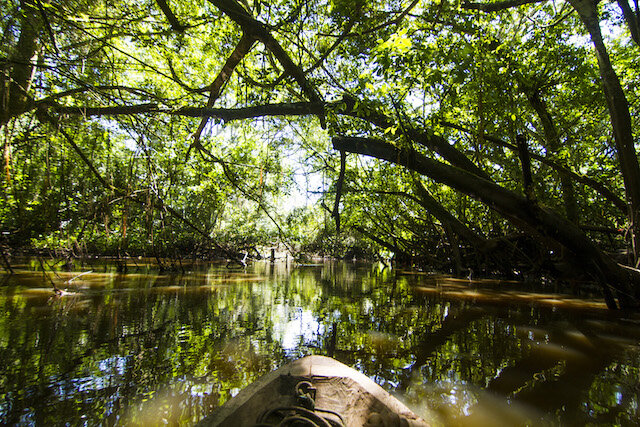Tingana is a spectacular and unique, community-run, nature reserve protecting 1,737 hectares (4,292 acres) of upper Mayo River rainforest, in the Rioja and Moyobamba districts of San Martin province.
Canoeing under Tingana’s low-hanging jungle canopy.
Set at approximately 800 m (2,600 ft) above sea level, and located in the watersheds of the Avisado and Romero rivers, Tingana is home to the highest flooded forest in Peru.
As such, it is known as an ‘amphibious reserve’ and it is best explored by dugout canoe, in which one can silently access the small creeks and glide under the overhanging branches.
History of Tingana Reserve:
Entrance to Tingana Reserve.
In 2004, seven local families set up ADECARAM, a conservation association which is committed to preserving this beautiful environment and promoting eco-tourism.
Today, these families keep the river system clean, and work as guides to visitors. They also offer simple accommodation in Tingana village.
Biology of Tingana Reserve:
The meeting of headwaters and jungle creates an impressive biodiversity, with many endemic and/or endangered species. Below is just a small snapshot of the flora and fauna that may be encountered at Tingana:
Fig trees and bromeliads in Tingana Reserve.
Flora:
The dominant tree species are fig (Ficus sphenophylla) and the moriche palm (Mauritia flexuosa) which thrive in wet conditions. Clinging to these larger trees are numerous species of ferns, vines, orchids & bromeliads.
Mammals:
South American coati (Nasua nasua)
Brown-throated Sloth (Bradypus variegatus)
Neotropical River Otter (Lontra longicaudis)
Giant Anteater (Myrmecophaga tridactyla)
Various Monkey species:
Tufted Capuchin (Sapajus apella)
Pygmy Marmoset (Cebuella pygmaea)
Squirrel Monkey (Saimiri sciureus)
Large-headed Capuchin (Sapajus macrocephalus)
Birds:
Striated heron taking flight.
Ringed Kingfisher (Megaceryle torquata)
American Pygmy Kingfisher (Chloroceryle aenea)
Amazon Kingfisher (Chloroceryle amazona)
Limpkin (Aramus guarauna)
Speckled Chachalaca (Ortalis guttata)
White-throated Toucan (Ramphastos tucanus)
Striated Heron (Butorides striata)
Great Egret (Ardea alba)
Armoured Catfish found in Amazon waters.
Fish:
Armoured Catfish (Pseudorinelepis genibarbis)
Blue Tilapia (Oreochromis Aureus)
Peruvian Mojarra (Diapterus peruvianus)
Swamp Eel (Synbranchus madeirae)
As you would expect of an Amazonian reserve, Tingana also contains a huge variety of amphibians, reptiles and insects.
How to visit Tingana Reserve:
Photographic opportunity in Tingana Reserve.
To reach the reserve, you need to take a speedboat for about an hour from the riverside port of Boca del Huascayacu, itself a 45-minute drive from Moyobamba.
There are day trips available from Tarapoto, which as well as visiting Tingana, often include a brief time at Palestine Caves. This is a lot to fit into one day, and necessitates a very early departure.
Preferable is to spend a night in the reserve, giving one the chance to explore by day and night, without the rush. PeruNorth has a two-day Tingana Reserve itinerary that does just that, with the option of adding a night in Moyobamba in order to visit the aforementioned Palestine Caves.







